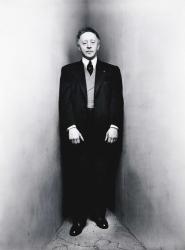Sound recordings from the first decades of the 20th century form a performance-practice treatise, documenting practices that may offer insight into music-making of earlier times. In the case of piano music, very many of these recordings are recordings of Chopin’s music. There are a lot of recordings of short pieces. (The length of one cylinder and later one “side” of a disc was around 3 minutes.)
Chopin: Waltz in A Minor, op. 34, no. 2, Robert Lortat, piano
Encountering pianist Robert Lortat’s 1930 recording of Chopin’s Waltz, op. 34, no. 2 sometimes provokes laughter from young pianists today. Lortat seems to avoid playing his hands together, quite intentionally. In this playing, the tempo shifts, sometimes suddenly with no transition. Some might say, Lortat is taking a lot of “liberty” with the piece, especially with regard to rhythm or time. Or, perhaps the notation of music as it was practiced in mid-19th-century Europe was a generalized, regularized writing-down of what real music did? Could even Michael Finnissy’s highly detailed notation represent the music Lortat makes at 2:00-2:11 in this recording?
(Of course, within this recording no editing was possible. An entire side could be done over, even many times, as Robert Philip documents in the case of solo piano recordings made by Sergei Rachmaninoff.)
Can I believe that 1930s piano playing has a strong relationship to 19th-century playing? Isn’t it possible that the “romantic” style became exaggerated — turned into mannerism? In a 1948 essay, Arnold Schoenberg reports:
“It must be admitted that in the period around 1900 many artists overdid themselves in exhibiting the power of the emotion they were capable of feeling…”
Much has been made of the differences between the rubato style of Paderewski (1860-1941) in the playing of music by Chopin, with left-hand frequently preceding right, and the somewhat later style of Arthur Rubinstein (1887-1982). Rubinstein himself suggested that he played with more regular rhythm and avoided breaking the hands. Of Paderewski, Rubinstein wrote: “He played Chopin in a very sentimental way. He used to break chords, for example. I fought that style because I knew that Chopin was better than that.”
Yet, after a 1940 concert, Virgil Thomson described Rubinstein’s playing:
“[Rubinstein’s] rubato is of the Paderewski tradition… The Paderewski tradition of Chopin-playing is more like the Viennese waltz style, in which the liberties in the melody line are followed exactly in the accompaniment, the two elements keeping always together and performing at the same time a flexible distortion of strict rhythm that manages by its very flexibility to keep the procedure from seeming arbitrary or the continuity from collapsing. Mr. Rubinstein is very skillful with this kind of rubato. He keeps the music surging.”
The anti-sentimental-rescuer-of-Chopin-from-excess trope persists in discussions of Rubinstein. For example, describing Rubinstein’s recordings, Anthony Tomasini wrote in the New York Times in 1999:
“He brings an almost Classical quality of restraint and refinement to music often subjected to emotive distortions in the name of rubato.”
In Paris, in a public discussion session with Rubinstein’s longtime producer Max Wilcox, Wilcox revealed something I found surprising: During the late 1950s and ’60s when editing had become possible, in his work on Rubinstein’s studio recordings, if the pianist’s hands were not together, Wilcox cut out bits of the recording tape, and fixed the “irregularity”!
Chopin: Nocturne in D-flat Major, op. 27, no. 2, Arthur Rubinstein, piano, 1965, Max Wilcox, producer
Mr. Wilcox is known as a producer with musical opinions. The fine craft of the editing in this nocturne recording makes it clear how closely he and his engineers were listening. How strongly Wilcox may have expressed himself to Rubinstein, and even influenced the pianist’s way of playing, I don’t know. Nor do I know if Rubinstein was aware that nuances were being trimmed from recordings of his playing. With the removing of hand-breaks, small bits of time, milliseconds were removed — altering overall musical rhythm.
Of course, Rubinstein himself may have wished to play differently for recording. (I’m thinking of the considerable differences between stage acting and acting for film.) It opens an area for exploration. I’d love to hear the unexpurgated playing Rubinstein did in the studio in the 1960s. Is the raw material still available? I believe the recorded playing of Rubinstein and others was modernized, manicured, sanitized, in the editing room.
Chopin: Nocturne in D-flat Major, op. 27, no. 2, Arthur Rubinstein, piano, 1964, Moscow (live)
Arthur Rubinstein photographed by Irving Penn in 1948


Wow Bruce, this was truly a great history lesson to me. As someone who really appreciates the history of the piano and of music in general, you were able to really educate me on Chopin, and I even learned a couple things I didn’t know.
You mentioned that Rubinstein may not have known that the nuances were being trimmed and edited from the recordings of his playings. I wonder if he would’ve been very upset about that. I agree with you, too, about the raw material of his 1960s work. I’d be curious to see if, whether it’s five years, ten years, or forty years from now, if we one day find some sort of “unearthed footage” of this, or if it’s just lost to history forever.
this is one of the best music lesson that i have read in my life.
Excellent history lesson here that I found very stimulating. Chopin has always been a favorite of mine. It is so soothing to listen to. Nocturne in D-flat Major is a great piece and Rubinstein is an extremely talented pianist. Its so difficult to come by such great talent.
Great article. It’s a very interesting and in-depth lesson on Chopin and the music of his time.